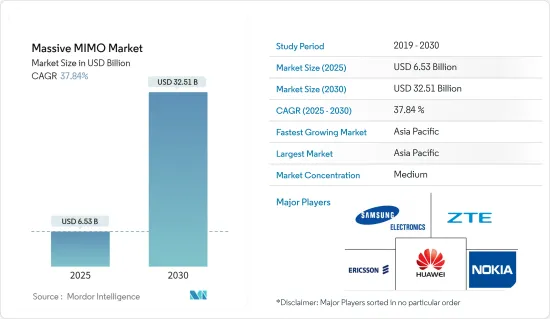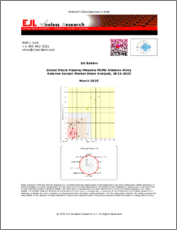
|
시장보고서
상품코드
1641885
Massive MIMO : 시장 점유율 분석, 산업 동향,통계, 성장 예측(2025-2030년)Massive MIMO - Market Share Analysis, Industry Trends & Statistics, Growth Forecasts (2025 - 2030) |
||||||
Massive MIMO 시장 규모는 2025년에 65억 3,000만 달러로 추정되며 예측 기간(2025-2030년)의 CAGR은 37.84%로, 2030년까지 325억 1,000만 달러에 달할 것으로 예측됩니다.

현재 약 52억 5,000만 명, 즉 세계 인구의 66.2%가 인터넷을 이용하고 있습니다. 인터넷의 보급률이 가장 높은 곳은 북미와 유럽으로 북미가 93.4%, 유럽이 88.4%입니다. 전 세계 인터넷 트래픽의 54.4%는 휴대전화 사용자가 소비하는 것으로 알려져 있습니다. 이러한 휴대폰 가입자의 급증과 온라인 이용 수요는 기존 네트워크에 부담을 주고 있습니다. 이 부담을 줄이기 위해 통신사는 MIMO와 같은 솔루션을 채택하여 소비자에게 빠르고 끊김없는 서비스를 제공합니다.
주요 하이라이트
- LTE에서 5G와 같은 네트워크 세대의 기술 발전은 끊김없는 연결에 대한 수요를 낳고 있습니다. 네트워크에 MIMO를 도입함으로써 시장은 기존의 4G FDD 네트워크의 혜택을 계속하면서 5G FDD 네트워크의 성능을 향상시킬 수 있습니다. 통신사업자는 5G 서비스 추진에 더욱 주력하고 있기 때문에 예측기간 동안 Massive MIMO 시장의 성장을 가속할 것으로 예상됩니다.
- 인터넷 사용은 COVID-19 팬데믹 동안 크게 증가했습니다. 온라인 교육, 재택 근무부터 원격 상담, 온라인 쇼핑에 이르기까지 고속 인터넷 서비스가 요구되고 있습니다. 통신 사업자는 광대역폭의 필요성을 인식하고 더 나은 연결성을 위해 MIMO와 같은 솔루션에 대한 수요를 만들었습니다.
- Wi-Fi 및 셀룰러 네트워크는 컴퓨터의 스펙트럼 효율, 최대 데이터 전송 속도 및 네트워크 성능을 향상시키기 위해 MIMO 기술을 사용합니다. MU-MIMO는 빔형성 공정이 복잡하고 효율이 나쁘기 때문에 고속으로 이동하는 장치에만 유효합니다. 따라서 MU-MIMO는 기업 네트워크를 자주 로밍하는 장치에는 효과가 없습니다.
대규모 다중 입력 다중 출력 시장 동향
5G 배포 증가가 시장 성장을 주도할 가능성
- Massive MIMO는 MIMO를 확대한 것으로, 기지국에 많은 수의 안테나를 설치함으로써 기존 시스템을 넘어 확장을합니다. 안테나 수 증가는 에너지 집중에 도움이 되고, 5G의 원활한 기능 발휘를 위한 처리량과 효율성이 크게 향상됩니다.
- 2022년 10월 -BT그룹의 인터넷 서비스 제공업체인 EE는 Ericsson과 제휴하여 Ericsson이 개발한 초경량 무선 기술을 사용하여 영국 전역에서 5G의 에너지 효율과 네트워크 성능을 실현했습니다. Ericsson은 이 기술이 에너지 효율이 뛰어나 에너지 사용량을 최대 40% 절감하는 최경량/최소의 Massive MIMO 라디오로 보다 광범위한 지속가능성 목표에 기여한다고 했습니다. 초기 단계에서 EE는 런던에서의 도입을 계획하고 있으며, 그 후 더 많은 도시와 교외로 확장할 계획입니다.
- 2022년 9월 - NEC와 Mavenir가 Massive MIMO 오렌지의 5G 독립형(SA) 실험 네트워크를 배포했습니다. 5G SA mMIMO 배포는 Open RAN을 개발하고 가상화 네트워크에서 클라우드화 네트워크로 전환하는 중요한 이정표입니다. 이러한 협업은 멀티 벤더, 클라우드 네이티브 및 표준 기반 접근법의 잠재력을 입증할 것입니다.
북미가 시장 점유율 1위
- GSMA 보고서에 따르면 미국은 2025년까지 세계에서 두 번째로 높은 5G 도입률을 달성할 것으로 예상됩니다. 5G 연결은 북미의 모든 모바일 연결의 64%를 차지하며, 2025년에는 2억 8,000만개에 달할 전망입니다. 미국과 캐나다는 통신사업자가 미드밴드 주파수대의 배치를 강화하고 2025년까지 캐나다에서 92%, 미국에서 100%의 인구 커버율을 달성하기 때문에 5G 보급률로 호조를 보일 것으로 예상됩니다.
- 게다가 GSMA는 T-Mobile이 2022년 1분기까지 90만명의 FWA 가입자를 가진 5G의 최대 공급자이며, 2025년까지 약 700만명의 가입자를 달성할 계획이라고 강조하고 있습니다. 5G FWA 시장은 캐나다 통신 사업자, 특히 지역에서도 조사되고 있습니다.
- 대부분의 통신사업자가 5G 기술에 많은 투자를 하고 있기 때문에 Massive MIMO는 예측기간 동안 이 지역에서의 도입률이 높아질 것으로 예상됩니다.
- 2022년 2월 - 미국의 오픈 RAN 기업 Parallel Wireless가 캐나다에 연구개발실을 개설할 예정입니다. 오타와에 우수한 R&D 팀을 보유하겠다는 비전을 가진 회사는 Massive MIMO, 시스템 아키텍처, 무선 설계 등과 관련된 신제품 개발을 기대하고 있습니다.
대규모 다입력 다출력 산업 개요
다수의 기업들이 존재하기 때문에 대규모 다입력 다출력(MIMO) 시장은 경쟁이 심합니다. 제품 라인업을 다양화하고 지리적 범위를 넓히고 궁극적으로 시장 경쟁을 유지하기 위해 기업은 제품 혁신, 합병, 인수 등의 방법을 실시했습니다. 이 시장의 주요 기업으로는 Verizon Communications Inc., Samsung Electronics, Telefonaktiebolaget LM Ericsson, Huawei Technologies 등이 있습니다.
- 2022년 6월-NXP는 5G Massive MIMO의 커버리지를 확대하기 위해 질화갈륨(GaN) 트랜지스터를 발표. 이 트랜지스터를 사용하면 도시와 교외에 5G MIMO를 설치할 수 있습니다. 이 트랜지스터는 통신 서비스 제공 업체가 미드 밴드의 광대역폭을 제공하고 전국에 강력한 5G 경험을 제공하기 위해 셀룰러 안테나를 구동하는 데 필요한 전력을 향상시킵니다.
- 2022년 9월 - Huawei가 필리핀에서 3세대 5G Massive MIMO의 배포를 개시. Meta AAU 제품은 트래픽 성능을 37% 향상시키고 업로드 및 다운로드 속도를 향상시켜 더 많은 사용자가 5G에 액세스할 수 있도록 합니다. 5G 네트워크는 필리핀 수도권 인구의 90%를 커버하고 있습니다.
기타 혜택
- 엑셀 형식 시장 예측(ME) 시트
- 3개월간의 애널리스트 서포트
목차
제1장 서론
- 조사의 전제조건과 시장 정의
- 조사 범위
제2장 조사 방법
제3장 주요 요약
제4장 시장 인사이트
- 시장 개요
- 산업의 매력 - Porter's Five Forces 분석
- 공급기업의 협상력
- 소비자의 협상력
- 신규 진입업자의 위협
- 대체품의 위협
- 경쟁 기업간 경쟁 관계
- 산업 밸류체인 분석
- COVID-19의 산업에 대한 영향 평가
제5장 시장 역학
- 시장 성장 촉진요인
- 모바일 기기 증가
- 5G 배포 증가
- 시장의 과제
- 기기의 고비용
제6장 시장 세분화
- 기술별
- LTE
- 5G
- 안테나 유형별
- 16T16R
- 32T32R
- 64T64R
- 128T128R 이상
- 지역별
- 북미
- 유럽
- 아시아태평양
- 기타
제7장 경쟁 구도
- 기업 프로파일
- Samsung Electronics Co. Ltd
- Telefonaktiebolaget LM Ericsson
- Huawei Technologies Co. Ltd
- Nokia Corporation
- ZTE Corporation
- Texas Instruments Incorporated
- Qorvo Inc.
- NEC Corporation
- Qualcomm Technologies Inc.
- Intel Corporation
제8장 투자 분석
제9장 시장의 미래
SHW 25.02.19The Massive MIMO Market size is estimated at USD 6.53 billion in 2025, and is expected to reach USD 32.51 billion by 2030, at a CAGR of 37.84% during the forecast period (2025-2030).

Approximately 5.25 billion people, i.e, 66.2% of the world's population, use the internet today. North America and Europe have the highest internet penetration of, 93.4% and 88.4%, respectively. It is believed that 54.4% of all internet traffic worldwide is consumed by mobile phone users. This surging demand for mobile subscribers and online usage is putting a burden on existing networks. To ease this pressure, telecom companies are adopting solutions, like MIMO, to provide uninterrupted services to their consumers with enhanced speeds.
Key Highlights
- The technological advancement in network generations like LTE to 5G also creates a demand for uninterrupted connectivity. With the introduction of MIMO in the networks, the market can continue to benefit from existing 4G FDD networks while enhancing the performance of 5G FDD networks. Since telcos focus more on promoting 5G services, it is expected to drive the growth of the massive MIMO market over the forecast period.
- The intensity of internet usage has increased substantially during the COVID-19 Pandemic. From online education, work from home to teleconsultation, online shopping demands high-speed internet services. Telecom operators realized the need for high bandwidth, which created the demand for solutions like MIMO for better connectivity.
- Wi-Fi and cellular networks employ MIMO technology to enhance a computer's spectrum efficiency, maximum data transmission rate, and network capability. It only works well with fast-moving devices because the beam-forming process is more complicated and less efficient. Therefore, MU-MIMO does not benefit devices that frequently roam your corporate network.
Massive Multiple-Input Multiple-Output Market Trends
Increasing 5G Deployment May Drive the Market Growth
- Massive MIMO is an extension of MIMO, that expands beyond the legacy systems by installing a significantly greater number of antennas on the base station. Increased number of antennas helps focus energy, which brings drastic improvements in throughput and efficiency for smooth functioning of 5G.
- October 2022 - EE, the internet service provider and part of BT group teamed with Ericsson to deliver 5G energy efficiency and network performance across the UK using the ultra-light radio technology developed by Ericsson. The company claims this to be the lightest and smallest Massive MIMO radio with energy efficient feature reducing up to 40% energy usage, contributing to wider sustainability goals. In the initial stages, EE plans to deploy the equipments in London, there after expanding to more urban and suburban areas.
- September 2022 - NEC and Mavenir deployed massive MIMO Orange's 5G standalone (SA) experimental network. the deployment of 5G SA mMIMO is an important milestone to develop Open RAN and make the switch from virtualized to cloudified networks. Such collaborations will prove the potential of the multi-vendor, cloud-native, standards-based approach.
North America Occupies a Significant Market Share
- According to GSMA's report, the US is expected to have the world's second-highest 5G adoption rate by 2025. The 5G connections will contribute 64% of all mobile connections in North America and will reach 280 million by 2025. US and Canada are expected to perform well in terms of 5G penetration as operators step up deployments of mid-band spectrum, taking overall population coverage to 92% in Canada and 100% in the US by 2025.
- Furthermore, GSMA highlited that T-Mobile is the biggest provider of 5G with 0.9 million FWA subscribers by the first quarter of 2022 and plans to achieve around 7 million subscribers by 2025. The 5G FWA market is also being investigated by Canadian operators, particularly in rural areas.
- With most of the telecom companies investing heavily in 5G technology, massive MIMO is expected to witness an increased rate of adoption in this region, during the forecast period.
- February 2022 - Parallel Wireless the U.S. based Open RAN company planned to open R&D lab in Canada. With a vision to have a stellar R&D team in Ottawa, the company look forward to develop new products related to massive MIMO, system architecture, radio design and more.
Massive Multiple-Input Multiple-Output Industry Overview
Due to numerous companies, the massive multiple-input, multiple-output (MIMO) market is highly competitive. To diversify their product offerings, broaden their geographic reach, and ultimately maintain their competitiveness in the market, the businesses are implementing methods including product innovation, mergers, and acquisitions. Some of the major players in the market are Verizon Communications Inc., Samsung Electronics Co. Ltd, Telefonaktiebolaget LM Ericsson, and Huawei Technologies Co. Ltd, among others.
- June 2022 - NXP launched Gallium Nitride (GaN) transistors to expand 5G Massive MIMO coverage. It will be easy to install 5G MIMO in cities and suburbs with the help of these transistors. These transistors enhance the power needed to drive cellular antennas for communication service providers to offer larger bandwidth of the mid-band to deliver powerful 5G experiences nationwide.
- September 2022 - Huawei began the rollout of third-generation 5G Massive MIMO in the Philippines. The Meta AAU product will increase traffic performance by 37%, and 5G will be accessible to more users with improved upload and download speeds. 5G networks have covered 90 percent of the population in the National Capital Region of the Philippines.
Additional Benefits:
- The market estimate (ME) sheet in Excel format
- 3 months of analyst support
TABLE OF CONTENTS
1 INTRODUCTION
- 1.1 Study Assumptions and Market Definition
- 1.2 Scope of the Study
2 RESEARCH METHODOLOGY
3 EXECUTIVE SUMMARY
4 MARKET INSIGHT
- 4.1 Market Overview
- 4.2 Industry Attractiveness - Porter's Five Forces Analysis
- 4.2.1 Bargaining Power of Suppliers
- 4.2.2 Bargaining Power of Consumers
- 4.2.3 Threat of New Entrants
- 4.2.4 Threat of Substitutes
- 4.2.5 Intensity of Competitive Rivalry
- 4.3 Industry Value Chain Analysis
- 4.4 Assessment of the Impact of COVID-19 on the Industry
5 MARKET DYNAMICS
- 5.1 Market Drivers
- 5.1.1 Increasing number of Mobile Devices
- 5.1.2 Increasing 5G Deployment
- 5.2 Market Challenges
- 5.2.1 High Cost of Equipment
6 MARKET SEGMENTATION
- 6.1 By Technology
- 6.1.1 LTE
- 6.1.2 5G
- 6.2 By Type of Antenna
- 6.2.1 16T16R
- 6.2.2 32T32R
- 6.2.3 64T64R
- 6.2.4 128T128R and Above
- 6.3 Geography
- 6.3.1 North America
- 6.3.2 Europe
- 6.3.3 Asia Pacific
- 6.3.4 Rest of the World
7 COMPETITIVE LANDSCAPE
- 7.1 Company Profiles
- 7.1.1 Samsung Electronics Co. Ltd
- 7.1.2 Telefonaktiebolaget LM Ericsson
- 7.1.3 Huawei Technologies Co. Ltd
- 7.1.4 Nokia Corporation
- 7.1.5 ZTE Corporation
- 7.1.6 Texas Instruments Incorporated
- 7.1.7 Qorvo Inc.
- 7.1.8 NEC Corporation
- 7.1.9 Qualcomm Technologies Inc.
- 7.1.10 Intel Corporation

















